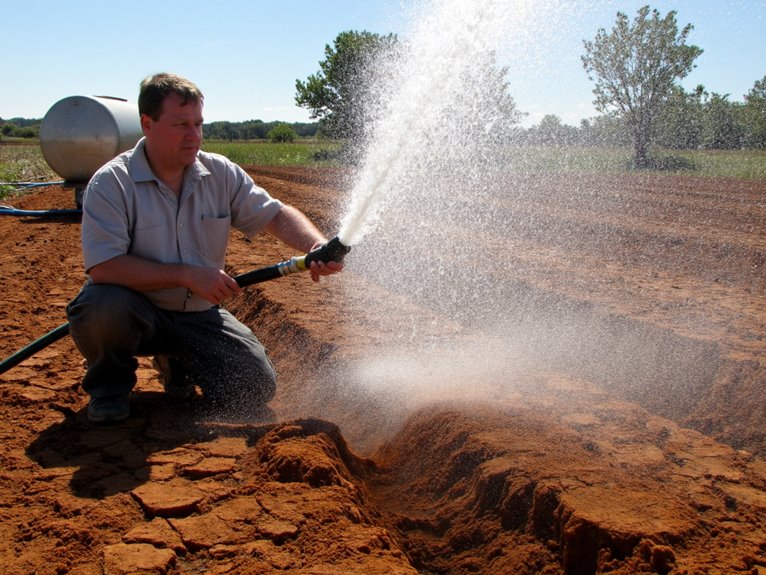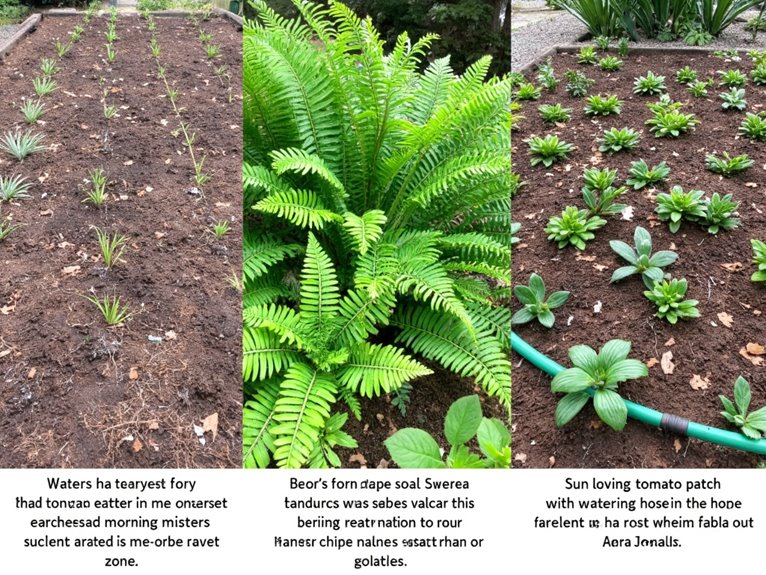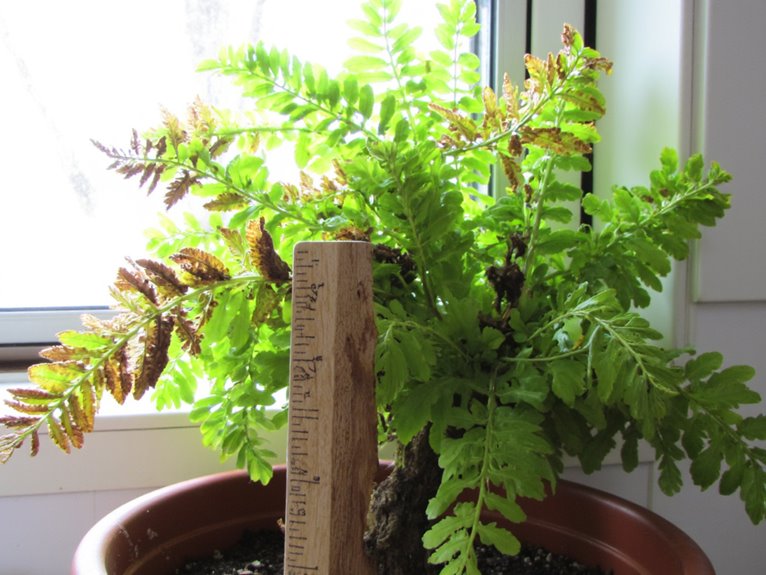Using Cold Water on Plants: Temperature Mistakes That Shock Roots
Using cold water on plants can shock roots, especially if temperatures drop below 25°F (-4°C), which stops nutrient uptake and damages membranes in sensitive species like tomatoes. Always research your plants’ specific needs before using cold water sources. If you must use colder water, do it gradually and avoid sudden drops that can slow growth or even kill container-grown plants. Proper temperature management helps maintain healthy root systems and better yields. For more tips on protecting plants from cold water stress, keep exploring gardening solutions.
Notable Insights
- Cold water shocks plants by slowing nutrient transport and enzyme activity crucial for root health.
- Sudden cold irrigation disrupts transpiration and can damage cellular membranes in sensitive species.
- Temperatures below 25°F (¬4°C) inhibit water uptake and halt protein synthesis in plant roots.
- Cold soils reduce phosphate and potassium absorption, impacting growth and yield potential.
- Microbial activity declines with cold inputs, disrupting nutrient cycling in aquaponics systems.
The Optimal Temperature Range for Root Health
While it might seem counterintuitive, keeping your plants’ roots at the right temperature is essential for their health and growth potential, much like how humans need a comfortable climate to function ideally. The root microbial balance thrives within specific temperature ranges, supporting nutrient cycling and disease resistance.
Temperature fluctuation effects can disrupt these processes, causing stress or slowing growth. For example, tomatoes prefer around 25ºC for their roots, while lettuce does better near 22ºC. Cold water can shock systems not adapted to it, especially tropical plants that need warmth. consistent temperature management helps maintain optimal microbial activity and nutrient uptake.
Maintaining consistent temperatures helps plants absorb nutrients efficiently and develop deeply. Always research your specific plants’ needs before watering with cold sources.
How Cold Water Disrupts Nutrient Uptake
Although it might seem like a simple act, watering plants with cold water can actually disrupt their fragile nutrient balance—especially when temperatures drop below what their roots are used to. Cold water slows Nutrient Transport Mechanisms by chilling root cells and impairing Enzyme Activity, crucial for nutrient absorption. This particularly hinders potassium and phosphate uptake, essential for growth and cellular function. In aquaponics, cold water also stalls bacterial metabolism, delaying ammonia conversion and risking toxic buildup. Plants may prioritize survival over growth, diverting resources from nutrient utilization. To support healthy uptake, consider warming irrigation water slightly, especially in cooler climates, to maintain ideal transport conditions without overheating. For growers monitoring plant health during temperature stress, using 60x magnification tools can help assess cellular damage and recovery in affected tissues.
Thermal Shock: Sudden Cold Drops Damage Roots
When you water plants with cold water, you might be disrupting nutrient uptake, but there’s another hidden danger: thermal shock. Sudden drops in temperature can stress plant resilience as roots struggle to adapt. Cold water shocks cellular structures, potentially freezing water inside cells and rupturing membranes.
The root cell membrane is particularly vulnerable to these temperature fluctuations, which disrupts the plant’s ability to regulate internal conditions. Soil insulation helps buffer against these temperature swings, protecting root systems from abrupt changes. Without it, fine root hairs are especially vulnerable. This damage disrupts metabolic processes, slowing growth and making plants more prone to disease.
To avoid thermal shock, match water temperature to your garden’s conditions. Let cold water warm slightly before use, and consider the time of day you water. Building soil insulation with organic matter offers extra protection for delicate roots. When roots are severely damaged, they may require more intensive intervention, similar to how chemical stump killers target root systems to prevent regrowth entirely.
Cold Water’s Impact on Root Development
As we investigate deeper into the effects of cold water on plants, it’s important to understand how these temperature changes specifically shape root systems. Cold water slows cellular division delays in meristems, altering root architecture changes and growth potential. Hormonal growth responses shift under low temperatures, disrupting normal development patterns. Soil moisture dynamics also change as cold roots show reduced hydraulic conductivity. Prolonged exposure can lead to cold induced diseases or even stunted seed germination temperatures. These temperature shifts impact mycorrhizal interactions and exudate composition shifts, further stressing plants. Building genetic cold tolerance in crops could help mitigate these negative effects on root systems. Cold water stress can significantly impair nutrient absorption, making it crucial to maintain proper watering temperatures especially when plants rely on essential micronutrients like magnesium, iron, and manganese for healthy development.
Yield Loss From Cold Irrigation Practices
Understanding how cold water impacts plant roots sets the stage for examining yield losses linked to cold irrigation practices. Cold irrigation timing effects matter most when water shocks developing plants—early treatments reduce shoot growth by 25% and root growth by 28%, while mid-stage applications cut yields by 14-15%. Repeated cold events compound these losses, with some crops experiencing up to 34% yield declines. Developing Gene cold resistance traits could help, but proper irrigation temperature management remains critical. While cooling water can mitigate heat stress, excessively cold inputs risk physiological shock, slowing nutrient uptake and delaying phenology. Balancing thermal regulation with plant resilience builds better outcomes than relying solely on genetic solutions.
Building Cold Tolerance Through Acclimation
While cold weather might seem like a threat to plants, it can actually be a valuable training ground when managed properly. Acclimation timing is key—gradual exposure to cooling temperatures signals plants to strengthen their defenses. This process boosts Genetic cold resistance through molecular changes like cryoprotectant production and membrane stabilization. Temperate species like winter cereals naturally prepare for frost, but tropical plants lack these mechanisms entirely. Gardeners can support acclimation by avoiding sudden temperature drops before plants are ready. Let your garden know when to slow down: as days shorten and temps fall, let plants redirect energy from growth to survival strategies. With thoughtful timing, cold becomes not just survivable—but even beneficial for resilient plant life.
Smart Watering Techniques for Cooler Conditions
When the thermometer drops, how you water becomes just as important as what you water. Smart systems use sensors placed near roots to monitor soil temperature and moisture levels, with algorithms optimizing watering times based on weather forecasts and plant needs. Drip irrigation delivers water directly to the root zone, minimizing cold shock.
| Method | Sensor Placement | Cool Benefits |
|---|---|---|
| Drip Irrigation | Near root zones | Minimal surface evaporation |
| Soaker Hoses | Below planting level | Even moisture distribution |
| Side Sprayers | At soil surface | Container plant hydration |
Program these systems to pause during frost, and water when air temps exceed 40°F. Check containers daily – cold water can shock roots even in mild winters.
Environmental Factors Exacerbating Cold Stress
Even as we refine our smart watering systems, plants face a complex dance of environmental stresses that can turn mild winters into real threats—when cold meets dry soil or sudden temperature drops catch them unprepared. Temperature gradients between air and ground levels create conflicting signals, while water temperature effects directly impact root zones. Cold soils hinder uptake, worsening drought impacts on already-stressed plants. Container-grown specimens suffer most from freezing-induced root shutdowns. These combined factors don’t just slow growth—they shock cellular processes, making recovery harder. Understanding how these environmental pressures interact with cold weather helps us build better protective strategies for our gardens.
Plant Variability in Cold Water Resistance
Let’s take a closer look at how plants vary in their ability to handle cold water and temperatures. Genetic diversity in cold resistance means some species naturally thrive in chillier climates while others wither quickly. For instance, snap peas and tomatoes can’t stand even light frosts, whereas lavender and cyclamen withstand much colder conditions. These differences stem from species-specific tolerance thresholds shaped by evolution and local environments. Cold-hardy plants often develop antifreeze proteins or flexible cell membranes that protect against ice damage. Meanwhile, frost-sensitive varieties may suffer root shock from sudden temperature drops. Understanding these variations helps gardeners choose appropriate watering methods and container plants for their climate zone.
Weighing Costs vs. Benefits of Heated Irrigation
Investing in heated irrigation reveals a nuanced balance between resource demands and agricultural rewards—potentially boosting yields while requiring thoughtful energy management. The cost effectiveness of these systems depends on factors like crop value and energy prices, with higher returns often seen in high-value produce like lettuce. Energy sustainability improves when solar power or waste heat is used, cutting reliance on fossil fuels. However, the initial infrastructure costs and ongoing maintenance can be significant for small-scale growers. Weighing these elements carefully secures heated irrigation supports growth without straining resources unnecessarily.
Frequently Asked Questions
What Temperature Range Is Safest for Root Irrigation?
The safest root irrigation temperature is 60°F to 70°F (15°C to 21°C). Cold Water Benefits include better nutrient uptake, while Root Temperature Risks like shock or dormancy happen outside this range. Keep it stable!
Do Cold Water Benefits Outweigh the Risks for Plants?
No, cold water risks often outweigh benefits for plants. It stresses roots, slows nutrient uptake, and causes temperature shock during irrigation. While it may boost some compounds in select species, the overall threat to root health and growth makes warm water safer for most plants.
How Does Watering Time Affect Cold Stress on Roots?
Watering time impacts cold stress on roots by when you use cold water—avoid midday watering when temperatures peak. Best timing is morning or evening for milder conditions. Seasonal adjustments matter too; cooler water works better in spring/fall than summer heat.
Can Cold Water Ever Improve Plant Health?
Yes, cold water can improve plant health by boosting defense compounds and strengthening root resilience when used wisely – but too much or too often can shock growth and slow development.
Are All Plant Species Equally Harmed by Cold Irrigation?
No, not all plants get cold irrigation equally—cucumber chilling shows how sensitive some are, while orchid frost damage reveals which ones can handle the shock better. You need to match water temps to your plants’ cold tolerance.
On a final note
Cold water can shock your plants’ roots, slowing growth and lowering yields. By understanding temperature ranges and using smart watering techniques, you protect root health while saving energy. Balance is key—keep it cool but never freezing. With these insights, you’re equipped to nurture resilient gardens year-round.






